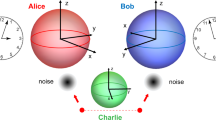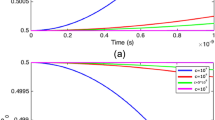Abstract
Quantum clock synchronization (QCS) is a kind of method to measure the time difference among spatially separated clocks with the principle of quantum mechanics. The first QCS algorithm proposed by Chuang and Jozsa is merely based on two parties, which is further extended and generalized to multiparty situation by Krco and Paul. They present a multiparty QCS protocol based upon W-state, utilizing shared prior entanglement and broadcasting the classical information to synchronize spatially separated clocks. Shortly afterward, Ben-Av and Exman came up with an optimized multiparty QCS based on Z-state. In this work, we firstly report the demonstrations of these two multiparty QCS protocols in a four-qubit liquid-state nuclear magnetic resonance system. The experimental results show a great agreement with the theoretical predictions and also prove that Ben-AV’s multiparty QCS algorithm is more accurate than Krco’s.







Similar content being viewed by others
References
Welch, J.L., Lynch, N.: A new fault-tolerant algorithm for clock synchronization. Inf. Comput. 77(1), 1–36 (1988)
Lewandowski, W., Azoubib, J., Klepczynski, W.J.: GPS: primary tool for time transfer. Proc. IEEE 87, 163–172 (1999)
Einstein, A.: Does the inertia of a body depend on its energy content? Ann. Phys. 18, 639641 (1905)
Eddington, A.S.: The Mathematical Theory of Relativity, 2nd edn. Cambridge University Press, Cambridge (1924)
Anderson, R., Vetharaniam, I., Stedman, G.E.: Conventionality of synchronisation, gauge dependence and test theories of relativity. Phys. Rep. 295, 93–180 (1998)
Jozsa, R., Abrams, D.S., Dowling, J.P., et al.: Quantum clock synchronization based on shared prior entanglement. Phys. Rev. Lett. 85, 2010–2013 (2000)
Long, G.L., Liu, X.S.: Theoretically efficient high-capacity quantum-key-distribution scheme. Phys. Rev. A 65, 032302 (2002)
Deng, F.G., Gui, L.L., Liu, X.S.: Two-step quantum direct communication protocol using the Einstein–Podolsky–Rosen pair block. Phys. Rev. A 68, 113–114 (2003)
Deng, F.G., Long, G.L.: Secure direct communication with a quantum one-time pad. Phys. Rev. A 69, 052319 (2004)
Wang, C., Deng, F.G., Li, Y.S., et al.: Quantum secure direct communication with high-dimension quantum superdense coding. Phys. Rev. A 71, 044305 (2005)
Preskill, J.: Quantum clock synchronization and quantum error correction. Preprint. arXiv:quant-ph/0010098 (2000)
Chuang, I.L.: Quantum algorithm for distributed clock synchronization. Phys. Rev. lett. 85, 2006 (2000)
Valencia, A., Scarcelli, G., Shih, Y.: Distant clock synchronization using entangled photon pairs. App. Phys. Lett. 85, 2655–2657 (2004)
Quan, R., Zhai, Y., Wang, M., et al.: Demonstration of quantum synchronization based on second-order quantum coherence of entangled photons. Sci. Rep. 6, 30453 (2016)
Zhang, J., Long, G.L., Deng, Z., et al.: Nuclear magnetic resonance implementation of a quantum clock synchronization algorithm. Phys. Rev. A 70, 062322 (2004)
Kro, M., Paul, P.: Quantum clock synchronization: multiparty protocol. Phys. Rev. A 66, 024305 (2002)
Ben-Av, R., Exman, I.: Optimized multiparty quantum clock synchronization. Phys. Rev. A 84, 014301 (2011)
Ren, C., Hofmann, H.F.: Clock synchronization using maximal multipartite entanglement. Phys. Rev. A 86, 014301 (2012)
Dr, W., Vidal, G., Cirac, J.I.: Three qubits can be entangled in two inequivalent ways. Phys. Rev. A 62, 062314 (2000)
Vandersypen, L.M.K., Chuang, I.L.: NMR techniques for quantum control and computation. Rev. Mod. Phys. 76, 1037 (2005)
Cory, D.G., Fahmy, A.F., Havel, T.F.: Ensemble quantum computing by NMR spectroscopy. Proc. Natl. Acad. Sci. 94, 1634–1639 (1997)
Lu, D., Xu, N., Xu, R., et al.: Simulation of chemical isomerization reaction dynamics on a NMR quantum simulator. Phys. Rev. Lett. 107, 020501 (2011)
Lu, Y., Feng, G.R., Li, Y.S.: Experimental digital quantum simulation of temporal-spatial dynamics of interacting fermion system. Sci. Bull. 60, 241–248 (2015)
Xin, T., Li, H., Wang, B.X., et al.: Realization of an entanglement-assisted quantum delayed-choice experiment. Phys. Rev. A 92, 022126 (2015)
Pearson, J., Feng, G.R., Zheng, C.: Experimental quantum simulation of Avian Compass in a nuclear magnetic resonance system. Sci. China Phys. 59, 120312 (2016)
Li, K., Long, G., Katiyar, H., et al.: Experimentally superposing two pure states with partial prior knowledge. Phys. Rev. A 95, 022334 (2017)
Chuang, I.L., Vandersypen, L.M.K., Zhou, X., et al.: Experimental realization of a quantum algorithm. Nature 393, 143–146 (1998)
Chuang, I.L., Gershenfeld, N., Kubinec, M.: Experimental implementation of fast quantum searching. Phys. Rev. Lett. 80, 3408 (1998)
Chuang, I.L., Gershenfeld, N., Kubinec, M.G.: Bulk quantum computation with nuclear magnetic resonance: theory and experiment. Phys. Eng. Sci. 454, 447–467 (1998)
Barenco, A., Bennett, C.H., Cleve, R.: Elementary gates for quantum computation. Phys. Rev. A 52, 34573467 (1995)
Khaneja, N., Reiss, T., Kehlet, C.: Optimal control of coupled spin dynamics: design of NMR pulse sequences by gradient ascent algorithms. J. Magn. Reson. 172, 296–305 (2005)
Ryan, C.A., Negrevergne, C., Laforest, M., et al.: Liquid-state nuclear magnetic resonance as a testbed for developing quantum control methods. Phys. Rev. A 78, 012328 (2008)
Jones, J.A., Knill, E.: Efficient refocusing of one-spin and two-spin interactions for NMR quantum computation. J. Magn. Reson. 141, 322–325 (1999)
Acknowledgements
We are grateful to the following funding sources: National Natural Science Foundation of China under Grant Nos. 11774197 and 91221205; National Basic Research Program of China under Grant No. 2015CB921002.
Author information
Authors and Affiliations
Corresponding author
Additional information
Project supported by the National Natural Science Foundation of China (Grant Nos. 11774197 and 91221205), the National B5. The experimental details are still not presented with any clarity. In particular, experimental realization of step 3 being the phase delay and measurements. National Basic Research Program of China (2015CB921002).
Appendices
Appendix A: GRAPE robustness profiles
As we all know the GRAPE technical is to realize the optimal control of the coupled spin dynamics [31]. In this method, the chosen transfer time T is discretized in N equal steps of duration \(\Delta t=T/N\) and during each step, the control amplitudes are constant. The time evolution of the spin system during a time step j is given by the propagator
where the \(H_0\) is the internal Hamiltonian in Eq. 14, the \(X_j\) and \(Y_j\) are amplitudes of the radiofrequency (RF) pulses applied on the x and y axis, the \(A_j\) and \(\phi _j\) are the amplitudes and phases of RF pulses. The final density operator at time \(t=T\) is
In our experiments to realize U in Eq. 17, we choose the \(T=20\) ms, \(N=4000\), \(\Delta t=5\upmu \)s, the \(A_j\) and \(\phi _j\) are calculated by the GRAPE method [31]. The pulses to realize U are designed to be robust to the static field distributions, RF inhomogeneity and decoherence. Then, we will prove the robustness in detail.
1.1 Static field distributions
In Ref. [20], we know that the static field distributions \(B_0\) only have the influences on \(\nu _j\) in the internal Hamiltonian \(H_0\). So we add some noises on \(B_0\) and the \(\nu _j\) in the Eq. 17 can be rewritten as \(\nu _j+\Delta \nu _j\). We assume that \(\Delta \nu _j\) is changing from \(-10\) Hz to 10 Hz for the real experimental noise is far less than 10 Hz. We compare the final density matrix with the theoretical value to obtain the fidelity. As shown in Fig. 8, the fidelities are all more than 0.99.
1.2 RF inhomogenezity
The radiofrequency (RF) pulses are applied on the x and y axis, the \(A_j\) and \(\phi _j\) are the amplitudes and phases of RF pulses. Similarly, we assume that the noise \(\Delta A_j\) is changing from \(-10\) Hz to 10Hz and the \(\Delta \phi _j\) is changing from \(-5^{\circ }\) to \(5^{\circ }\). As shown in Fig. 9, the fidelities are all more than 0.996.
1.3 Decoherence
The final density at time \(t=T\) is given by the Eq. 25. Considering the influence of decoherence, the time evolution of the spin system during a time step j is approximately given by the propagator:
where \(\sigma _x\) is \(2\times 2\) Pauli operator, \(T_2^i\) are the decoherence time of ith carbon atom as shown in Fig. 2. Finally, we can obtain the fidelities with the influence of decoherence in the Table 2 and the result proves that our method are robust with decoherence with a length of 20 ms.
Appendix B: Fitting of the experimental spectrum
See Figs. 8, 9, 10 and Table 2.
The fitting of the spectrum of spin C4 in the final state. As shown in the Fig. 5f, we can not obtain the values of peaks directly. Through the method of fitting, we can obtain the values of peaks. The fitting results of \(|000\rangle \), \(|001\rangle \), \(|010\rangle \) and \(|011\rangle \) are 0.2824, 0.0123, \(-\,0.0143\) and \(-\,0.0118\)
Rights and permissions
About this article
Cite this article
Kong, X., Xin, T., Wei, SJ. et al. Demonstration of multiparty quantum clock synchronization. Quantum Inf Process 17, 297 (2018). https://doi.org/10.1007/s11128-018-2057-9
Received:
Accepted:
Published:
DOI: https://doi.org/10.1007/s11128-018-2057-9







